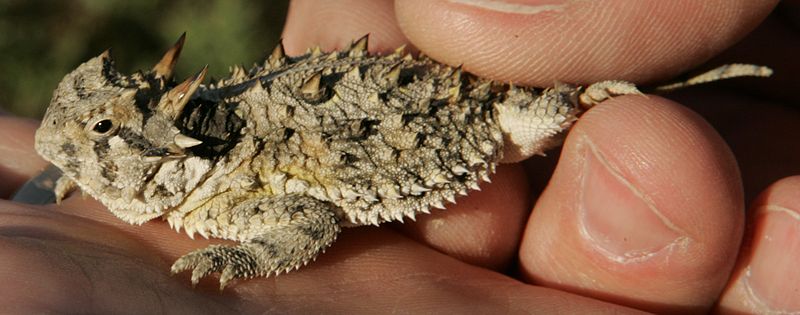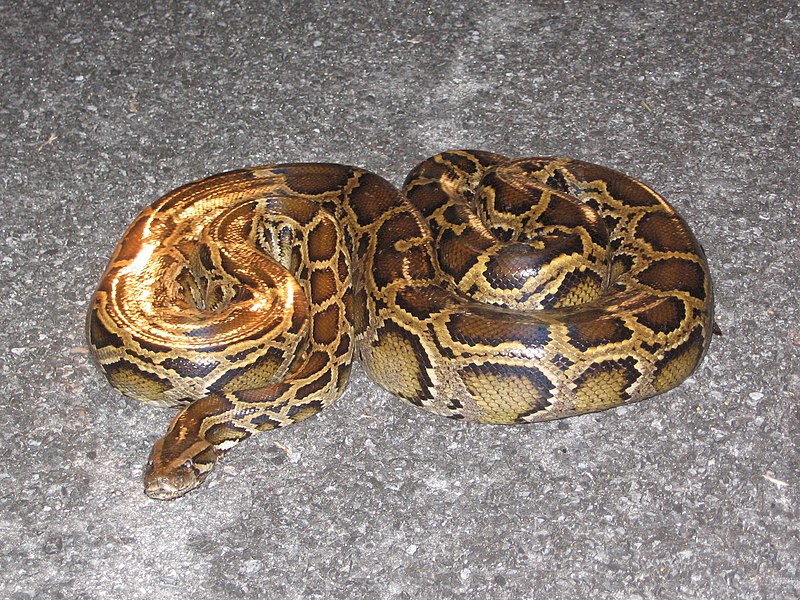 Horned Lizards of various species, usually sold as “Horned Toads”, were US pet trade staples in the 1950’s and 60’s. Looking much like minute dinosaurs, they needed more heat and UVB than most could provide, along with an ant-dominated diet, and fared poorly. As a boy, I was able to keep them going in the summer, thanks to natural sunlight and plentiful ants, but they declined in winter (I discovered they did not like the “house ants” I collected in local stores!). As I moved into zoo work, the key to keeping most species remained elusive. So I was very happy to hear that the Los Angeles Zoo had recently (January, 2011) succeeded in breeding the largest species, the Giant Horned Lizard, Phrynosoma asio. Read More »
Horned Lizards of various species, usually sold as “Horned Toads”, were US pet trade staples in the 1950’s and 60’s. Looking much like minute dinosaurs, they needed more heat and UVB than most could provide, along with an ant-dominated diet, and fared poorly. As a boy, I was able to keep them going in the summer, thanks to natural sunlight and plentiful ants, but they declined in winter (I discovered they did not like the “house ants” I collected in local stores!). As I moved into zoo work, the key to keeping most species remained elusive. So I was very happy to hear that the Los Angeles Zoo had recently (January, 2011) succeeded in breeding the largest species, the Giant Horned Lizard, Phrynosoma asio. Read More »
Category Archives: Breeding
Feed SubscriptionInvasive Species News – African Rock Pythons may be Breeding in Florida
 A recent article in the journal IRCF Reptiles and Amphibians (V17, 1) provides evidence that the African Rock Python (Northern African Python, Python sebae), may have established a breeding population in southern Florida. The huge constrictors are adapted to take small antelopes and other large animals, and have been killed and consumed people in their native habitat.
A recent article in the journal IRCF Reptiles and Amphibians (V17, 1) provides evidence that the African Rock Python (Northern African Python, Python sebae), may have established a breeding population in southern Florida. The huge constrictors are adapted to take small antelopes and other large animals, and have been killed and consumed people in their native habitat.
Florida’s Introduced Constrictors
At least 45 species of non-native reptiles and amphibians have established breeding populations in Florida; many others have been observed but are not known to be reproducing. Among these are 2 of the world’s largest snakes, the Burmese Python and the Boa Constrictor. Other large constrictors, including the Green Anaconda, Yellow Anaconda and White-Lipped Python, have been found at large in Florida.
Anacondas and others Established?
Given the extent of Florida’s wetlands and other densely-vegetated habitats, it is not unlikely that reproduction of other species has occurred unseen. Anacondas, being aquatic, are especially difficult to find. Years ago, I was told by a reliable source that an entire litter of Green Anacondas escaped from a roadside zoo near Florida City in the early 1970’s…nothing would surprise me at this point!
Northern African Python Study
The article mentioned above looked at Northern African Python sightings and captures in south Florida from 2002-2009. In that period, 7 individuals were found in a small (less than 10 square miles) area in Dade County. Among the captured snakes was an 15.5 foot-long adult female with eggs forming in the oviduct, reproductively active males, and several young-of-the-year. The ages and sexes of these snakes, and their proximity to one another, suggests a breeding population.
Also notable is the fact that the capture sites were less than 1 mile from the border of the Everglades, an immense habitat that could easily hide other African Rock Pythons.
Recent meals – a Domestic Turkey and a Boat-tailed Grackle – were recovered from 2 of the snakes.
Python Hybrids
 The African Rock Pythons were found in an area that abuts or overlaps with the range of Florida’s introduced Burmese Pythons. The 2 species will mate with one another in captivity; the fertility of the resulting hybrids, and their possible affect on south Florida ecosystems, bears further study.
The African Rock Pythons were found in an area that abuts or overlaps with the range of Florida’s introduced Burmese Pythons. The 2 species will mate with one another in captivity; the fertility of the resulting hybrids, and their possible affect on south Florida ecosystems, bears further study.
Further Reading
The African Rock Python in Florida (National Geographic)
Video: Rock Python found in Florida
News Article, Photo: African Rock Python Captured in Florida
Study: Burmese Python Winter Tolerance
Python Sebae image referenced from wikipedia and originally posted by Brian.Gratwicke
New Product – Artificial Bromeliads as Poison Frog Breeding Sites – Part 1
 Today I’d like to introduce Hagen’s Smart Plants, a new line of artificial plants that hold great promise for those keeping Poison Frogs (Dendrobates, Phyllobates, etc.) and arboreal snakes, tarantulas, crabs and similar creatures. Read More »
Today I’d like to introduce Hagen’s Smart Plants, a new line of artificial plants that hold great promise for those keeping Poison Frogs (Dendrobates, Phyllobates, etc.) and arboreal snakes, tarantulas, crabs and similar creatures. Read More »
Assassin Bugs – Captive Care and a Spider-Hunting Assassin – Part 2
 Please see Part 1 of this article to learn about Assassin Bugs that lure prey by tricking spiders and termites.
Please see Part 1 of this article to learn about Assassin Bugs that lure prey by tricking spiders and termites.
Commercially Available Species
West Africa’s White-Spotted Assassin Bug (Platymeris biguttatus) and the Red-Spotted Assassin (P. rhadamanthus) of East Africa are sometimes offered for sale in the USA and are well-established in private and public insect collections.
Warning: All Assassin Bugs can administer a painful bite with their sharp proboscis, or rostrum. As infection and an allergic reaction to their venom are distinct possibilities, they should only be kept by well-experienced adults. These and other species can also spray their venom, so protective eyewear is a must. All Assassin Bugs, including the US natives, should be handled only with forceps. Read More »
A Monitor First – Male Rosenberg’s Monitors Cover and Guard Nests
 I remain awed by the learning abilities and complex behaviors evidenced by the Water and Lace Monitors I cared for at various zoos…spend time with any species and you’ll quickly see why. Despite being popular study subjects, monitors are constantly surprising us. For example, the current issue of The Journal of Herpetology (V44, N3, Sept 2010) documents an entirely new behavior for any monitor species – cooperative nest building and nest guarding in Rosenberg’s Monitor (Varanus rosenbergi).
I remain awed by the learning abilities and complex behaviors evidenced by the Water and Lace Monitors I cared for at various zoos…spend time with any species and you’ll quickly see why. Despite being popular study subjects, monitors are constantly surprising us. For example, the current issue of The Journal of Herpetology (V44, N3, Sept 2010) documents an entirely new behavior for any monitor species – cooperative nest building and nest guarding in Rosenberg’s Monitor (Varanus rosenbergi).
Nest Defense by both Sexes
A 16-year-long study of this species on Australia’s Kangaroo Island has revealed that females guard their nest sites for up to 3 weeks after egg deposition, a behavior that has not been documented for any other monitor (3 species, including the Komodo Dragon, may return to the nest site on occasion, but seem not to remain nearby). Amazingly, in 8 instances a male joined the female in protecting the eggs. Read More »
 That Reptile Blog – Reptile, Amphibian and Exotic Pet Care and Information
That Reptile Blog – Reptile, Amphibian and Exotic Pet Care and Information
